dimanche, 03 mai 2015
Der vergessene Reaktionär
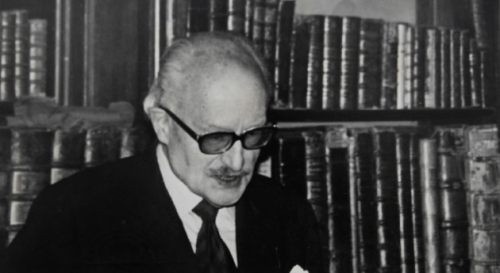
Der vergessene Reaktionär
von Christoph Schmidt
Ex: http://www.blauenarzisse.de
Der Kolumbianer Nicolás Gómez Dávila ist einer der interessantesten reaktionären Denker. Nun erschien eine stark erweiterte Neuauflage der einzigen deutschsprachigen Dávila-Monografie. Die Lektüre lohnt sich.
Zu verdanken ist das dem kleinen katholischen Lepanto Verlag: Er hat das erstmals im Jahre 2003 bei Edition Antaios erschienene Buch von Till Kinzel wieder aufgelegt.
Gestalterisch ungewöhnlich kommt dieses Buch daher: Das Format des vorliegenden Werkes ist ziemlich hochkantig ausgefallen und erschwert anfänglich das normale Umblättern. Nach einiger Zeit der Gewöhnung vermag jedoch das Format mit dem Inhalt eine Symbiose einzugehen. Die kernige Prägnanz des Textes harmonisiert mit der Haptik des Buches.
Ein Leben in Kolumbien
Prägnant ist auch der Einstieg: Der Literaturwissenschaftler und Historiker Till Kinzel liefert einige biografische Eckdaten und versucht Dávilas (1913 bis 1994) Wirken in einen historisch-geografischen Kontext einzubetten. Dieser Passus ist merklich kurz gehalten. Das ist vor allem der Tatsache geschuldet, dass der Aphoristiker Dávila ein unaufgeregtes Leben im Kreise engster Bekannten geführt hat. Dávila nannte das „klarsichtig ein schlichtes, verschwiegenes, diskretes Leben führen, zwischen klugen Büchern, einigen wenigen Geschöpfen in Liebe zugetan.“
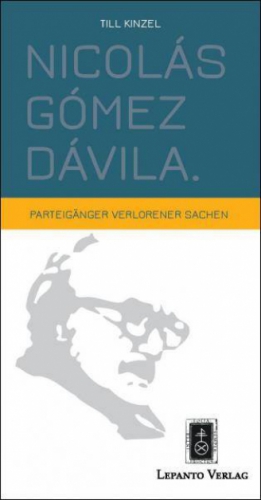 Das wird auch dadurch deutlich, dass erst im Jahre 1954 das erste Mal etwas von Dávila veröffentlicht wurde – allerdings als Privatdruck. Dávila war davon anfänglich nicht begeistert. Er hat sich im Laufe seines Lebens kaum um die Verbreitung seiner Schriften bemüht. Kinzel orientiert sich an Dávilas Bemerkung, dass der Biograph nicht die Frage nach dem „Warum“ einer Person zu stellen, sondern vielmehr die Frage nach dem „Wie“ zu bearbeiten habe. Deshalb rückt er Dávilas Denken und Stil in dieser Monografie in den Vordergrund.
Das wird auch dadurch deutlich, dass erst im Jahre 1954 das erste Mal etwas von Dávila veröffentlicht wurde – allerdings als Privatdruck. Dávila war davon anfänglich nicht begeistert. Er hat sich im Laufe seines Lebens kaum um die Verbreitung seiner Schriften bemüht. Kinzel orientiert sich an Dávilas Bemerkung, dass der Biograph nicht die Frage nach dem „Warum“ einer Person zu stellen, sondern vielmehr die Frage nach dem „Wie“ zu bearbeiten habe. Deshalb rückt er Dávilas Denken und Stil in dieser Monografie in den Vordergrund.
Doch Dávila war im großen Maße mit seinem Heimatland Kolumbien verbunden. Er war Zeit seines Lebens nur zweimal – in Form des Schulbesuchs in Paris und einer sechsmonatigen Reise durch Europa – im Ausland. Schlüssig arbeitet Kinzel das Verhältnis zwischen Land und Denker heraus und durchleuchtet Dávilas Beziehung zu seinen literarischen Kollegen. Dazu gehören beispielsweise der linksgerichtete Gabriel García Márquez und der langjährige Freund Álvaro Mutis.
Der reaktionäre Denker
Laut Kinzel zeichnet sich Dávilas Stil durch einen kurzen und elliptischen, also unvollständigen und verkürzten Ausdruck aus – eben ganz im Sinne eines Reaktionärs. Der Reaktionär besitzt nämlich kein geschlossenes System oder theoretisches Konstrukt. „Die Idee, die sich zu einem System entwickelt, begeht Selbstmord“, so der Kolumbianer. Dávila hat seine Meisterschaft im Aphorismus jedoch vielmehr als Glossen und Kommentare zu einem inbegriffenen Text aufgefasst. Sie würden quasi als Epilog zu einem nicht existierenden Werk fungieren.
Die Haltung des Reaktionärs zeichnet sich dadurch aus, dass er sich für die verlorenen Sachen einsetzt und als dessen Parteigänger handelt. Dabei war Gómez Dávila durchaus bewusst, dass die Kritik an der Moderne und einer fanatischen und dogmatischen Aufklärung kaum Gehör finden würde. Es gehe letztendlich darum, als Reaktionär würdig Schiffbruch zu erleiden. Dávila zeichnet sich vor allem dadurch aus, dem Leser die Fragwürdigkeit der globalisierten Welt vor Augen zu führen. Kinzel geht zudem auf Dávilas Vernunftbegriff und dessen Verständnis der Seele ein. Auch die ästhetische Grundauffassung und die Haltung zur Demokratie werden herausgearbeitet.
Vernunft und Ästhetik
Dávilas Denken beinhaltet einen reichen Strauß an Ideen, Vorstellungen und Einstellungen. Doch um jedweden Denker näher kennenzulernen, bedarf es immer zuerst einen Einblick in die Grundverständnisse desselben. Für Dávilas Denken ist vor allem seine Auffassung der Vernunft von Relevanz. Orientierungspunkt stellt bei ihm die sogenannte „Philosophia perennis“ dar. Sie beruft sich auf die Vernunft der klassischen Philosophie und hält an den bleibenden Thesen der abendländischen Philosophie seit Platon und Aristoteles fest.
Diese Auffassung ist jedoch nicht mit dem dogmatischen Vernunftbegriff der aufgeklärten Moderne gleichzusetzen. Daraus resultiert eine besondere Aufgabe der Philosophie bei Dávila – nämlich die Erkenntnis der Realitäten und die Wiederherstellung des Realitätsbezuges in der Gegenwart. Sie sei durch die Ideen der Moderne gleichsam gefährdet, die denkerische Systematisierung von Realitäten sei dagegen vernachlässigbar.
Besonders bemerkenswert bleibt Dávilas Bemühen um literarische Ästhetik. Kinzel dazu: „Sein Text gleicht einem Gemälde, zu dessen angemessener Entschlüsselung zweierlei nötig ist: genaue Betrachtung der einzelnen Farbpunkte (d.h. der einzelnen Sätze), aber auch ein Zurücktreten von dieser Detailbetrachtung, um einen Gesamteindruck des Kunstwerkes zu erlangen.“
Demokratie und Erbsünde
Ein weiterer wichtiger und grundlegender Aspekt im Denken Dávilas ist sein starker katholischer Impetus. Kinzel legt dar, dass ohne die Idee der Erbsünde Dávilas Philosophie nicht nachvollziehbar sei. Denn wer diese leugnet, wäre letztlich gottlos, da sich die Erbsünde mit dem Glauben an Gott in einer notwendigen Wechselbeziehung befände. Diese konsequente Haltung führt zur Kritik an einen säkularen Ethikbegriff.
Ähnlich kritisch beäugt Gómez Dávila die säkulare Heilsversprechung des egalitären Demokratismus. Dieser Begriff bedeutet nichts anderes als die Demokratisierung sämtlicher Lebensbereiche. Diese hochgradige Ideologisierung der Demokratie führe letztlich zu einem Antielitismus, dem eine wahrhaftig aristokratische Gesellschaft gegenüber stehe. Dávila übt damit scharfe Kritik an säkularen Konzeptionen jedweder Couleur. Der Reaktionär empfindet sich jedoch jenseits vom rechten und linken Parteienlager: „Die Linke nennt jene Leute Rechtsparteiler, die bloß rechts von ihnen sitzen. Der Reaktionär befindet sich nicht auf der rechten Seite von der Linken, sondern gegenüber.“
Empfehlenswerte Einführung
Kinzels Dávila-Monografie ist uneingeschränkt all jenen zu empfehlen, die bisher noch keinen tiefgründigen Kontakt mit dem kolumbianischen Reaktionär hatten. Der Kenner der Materie wird sich wiederum an den nuancierten Deutungen Kinzels abarbeiten und sein Denken rund um Dávila konkretisieren können. Hoffen wir, dass der lange Zeit eher als konservativer Geheimtipp bekannte Dávila wieder vermehrt in die rechte Öffentlichkeit gerät. Verdient hätte er es.
Till Kinzel: Nicolás Gómez Dávila. Parteigänger verlorener Sachen. 215 Seiten. Lepanto Verlag 2015. 12,90 Euro.
00:05 Publié dans Livre, Livre | Lien permanent | Commentaires (0) | Tags : livre, nicola gomez davila, colombie, amérique latine, amérique du sud, pensée réactionnaire, réaction, conservatisme |  |
|  del.icio.us |
del.icio.us |  |
|  Digg |
Digg | ![]() Facebook
Facebook
jeudi, 19 mai 2011
A Brief Overview of Nicolas Gomez Davila's Thought
A Brief Overview of Nicolás Gómez Dávila's Thought
http://don-colacho.blogspot.com/
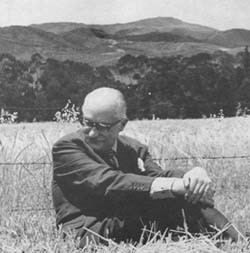 I: Introduction
I: Introduction
The most subversive book in our time would be a compendium of old proverbs.
Nicolás Gómez Dávila was a man of wide-ranging interests, and his aphorisms reflect that fact. Although he was to a certain extent an autodidact—he received an excellent secondary education, but never attended university, instead relying on his voluminous library—he may rightfully be considered one of the great thinkers of the 20th century. Among the scholarly topics he wrote about are religion, philosophy, politics, history, literature, aesthetics, and more. Besides these scholarly interests, however, many of his aphorisms betray a more personal dimension, with intimate observations on topics like love and the process of aging.
Gómez Dávila by all accounts valued his privacy and was concerned primarily with finding the truth for himself. Why then, would he write down his thoughts and observations in aphorisms and even publish them, however secretively? Gómez Dávila was, quite possibly, writing a subversive collection of proverbs himself. He disavowed originality, and maintained that he desired only wisdom for himself, but despite his protests that he was not trying to convert anyone to his way of thinking, perhaps he secretly did harbor a hope that he might rouse a few souls from their dogmatic slumber. Of course, Gómez Dávila never resorted to a loud and vulgar way of awakening us moderns; he wrote his aphorisms so that anyone who happened to come across them might be inspired by a wisdom that is ancient yet ever young.
Unfortunately, this wisdom is largely foreign to us today, and precisely for that reason, so subversive. There are, then, quite a few aspects of Gómez Dávila’s work that merit closer examination.
II: Why aphorisms?
The first and most obvious is the very form of Gómez Dávila’s work: aphorisms. There has been some speculation about the motivations behind Gómez Dávila’s choice to write aphorisms, even though he himself gave the most important reason in Notas. In this early work, he stated that the only two “tolerable” ways to write were a long, leisurely style, and a short, elliptical style. However, since he did not think himself capable of the long, leisurely style, he opted for aphorisms. Aphorisms, according to Gómez Dávila, are like seeds containing the promise of “infinite consequences.” Another way to think of these aphorisms is to say that aphorisms are like the summits of ideas, which allow the reader to imagine the massive mountain beneath. The sheer number of aphorisms, then, helps take place of the long, metaphysical meditation Gómez Dávila wished for; each aphorism puts another in its proper context, and taken all together, they provide an outline of the implicit text mentioned in the title. But just as importantly for Gómez Dávila, these aphorisms, while providing context for each other, cannot be made into a thought-deadening system.
Another function that Gómez Dávila’s aphorisms served was, as their Spanish title (Escolios a un Texto Implícito) suggests, as notes on books he had read. The Spanish word escolio comes from the Greek σχόλιον (scholion). This word is used to describe the annotations made by ancient and medieval scribes and students in the margins of their texts. Many of these aphorisms, then, are allusions to other works. They constitute the briefest of summaries of works he read, conclusions he had drawn from these works, or judgments on these works.
Finally, Gómez Dávila’s use of aphorisms was also motivated in part by polemical considerations. In the modern age, the reactionary cannot hope to formulate arguments that will convince his opponent, because he does not share any assumptions with his opponent. Moreover, even if the reactionary could argue from certain shared assumptions, modern man’s dogmatism prevents him from listening to argumentation. Faced with this situation, the reactionary should instead write aphorisms. Gómez Dávila compares his aphorisms to shots fired by a guerrilla from behind a thicket on any modern idea that dares advance along the road. The reactionary will not convince his opponent, but he may convert him.
III: What is a reactionary?
The second extraordinary feature of Gómez Dávila’s work is its “reactionary,” not merely conservative, content. “Reactionary” is mostly used today as an abusive epithet, sometimes as a synonym for that all-purpose slur, “fascist.” However, Gómez Dávila proudly labeled himself a reactionary and actually created a literary persona for himself as “the authentic reactionary,” precisely because of the stigma attached to the term. Gómez Dávila’s lifework was to be an authentic reactionary.
The term “reactionary,” then, demands some explanation. The reactionary, in the common political sense, is a rare breed in America, primarily because of America’s own acceptance of the Enlightenment. The reactionary, in European history, as the name indicates, is fighting against something. That something is the French Revolution (and the Enlightenment). The conflict between the forces of the Enlightenment and the ancien régime was much more polarizing in Europe than it ever was in America. While America in the aftermath of its own revolution certainly witnessed its own share of power struggles between politicians with traditional, more aristocratic leanings (Federalists) and more radically democratic tendencies (Republicans), both sides generally accepted the legitimacy of Enlightenment ideals of liberal politics, which included democracy, individual rights, and a commercial society, among other things. There was, ex hypothesi, never any serious possibility that a group of disaffected American Tories would conspire to restore the authority of the British crown over the newly-independent United States.
In Europe, on the other hand, and especially in France, the conflict between the heirs of the French Revolution and its opponents—the original reactionaries—still raged during the time Gómez Dávila lived in Paris. Indeed, reactionary ideals exercised a powerful influence over certain sectors of French society until after World War II. One important reason for the persistence of reactionary ideals in France was the Catholic Church’s own resistance to modern liberalism (e.g., Pius IX’s Syllabus of Errors) and the persecution it often faced at the hands of secular governments following the Revolution, especially the ThirdRepublic. In France, Catholicism and reaction were often overlapping (though not always identical) categories. The tension between modern liberalism and reaction continued to be felt in French Catholic circles during Vatican II. Though reaction as a cohesive movement largely died in the wake of the Council, it has survived in some French Catholic circles to this day, most visibly among the Lefebvrites (SSPX).
Gómez Dávila’s brand of reaction, however, was different. He did not mean to identify himself exclusively with a narrow political position. In several aphorisms, he acknowledged that there is no possibility of reversing the course of history. Traditionalism, in his eyes, could never be a viable basis for action. Indeed, the reactionary’s task is to be the guardian of heritages, even the heritage of revolutionaries. This certainly does not mean that Gómez Dávila made his peace with democracy; all it means is that he also did not allow himself to be deluded by promises of the restoration of the old order. Moreover, in matters of religion, despite his disdain for Vatican II and his fierce adherence to the traditional Latin Mass, which he shared with most Catholic reactionaries, he recognized that the ordinary reactionaries, the so-called “integralists” of the period, were incapable of renewing the Church. For instance, he maintained in one aphorism that the Church needed to make better use of the historical-critical method of Biblical research—a suggestion which would make many ordinary reactionaries furious. Finally, his appreciation of some authors not usually associated with conservative Catholicism, such as Nietzsche and Heidegger, might make some “traditionalist” readers nervous.
If Gómez Dávila’s brand of reaction was different, what then did he actually stand for? For Gómez Dávila, the reactionary’s task in our age is to resist democracy. By democracy he means “less a political fact than a metaphysical perversion.” Indeed, Gómez Dávila defines democracy as, quite literally, “an anthropotheist religion,” an insane attempt to rival, or even surpass, God. The secret of modernity is that man has begun to worship man, and it is this secret which lurks behind every doctrine of inevitable progress. The reactionary’s resistance, therefore, is religious in nature. “In our time, rebellion is reactionary, or else it is nothing but a hypocritical and facile farce.” The most important and difficult rebellion, however, does not necessarily take place in action. “To think against is more difficult than to act against.” But, all that remains to the reactionary today is “an impotent lucidity." Moreover, Gómez Dávila did not look forward to the establishment of a utopia; what he wanted was to preserve values within the world. For this purpose, not force but art was the more powerful weapon.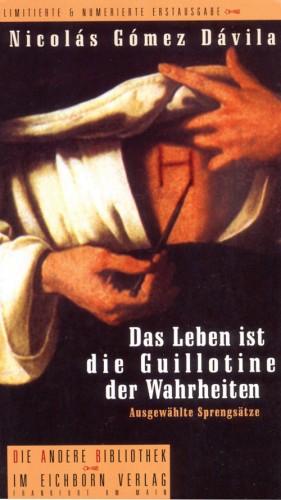 IV: Sensual, skeptical, religious
IV: Sensual, skeptical, religious
The third extraordinary feature of these aphorisms is Gómez Dávila’s unmistakable personality. Much of the pleasure of reading the Escolios consists in slowly getting to know this personality. While Gómez Dávila generally did not indulge in autobiography, in the privately-published Notas he was slightly less guarded about himself. In one line he declares: “Sensual, skeptical, and religious, would perhaps not be a bad definition of what I am.” These are the three basic strands of his personality and his work; they belong together, despite any contradictions the reader might think exist between them.
Sensual:
Gómez Dávila was aware that most people view sensuality and religion as contradictory, but he was determined to keep both these basic features of his personality together. He did not deny that sensuality, in isolation, can be a vice; instead of being discarded, however, it needs to be joined with love—love not of an abstract concept, but of an individual. Indeed, the object of love is the “ineffableness of the individual.” In Gómez Dávila’s philosophy, the sensual, by virtue of its union with love, is intimately united with the individual.
But, what exactly is the sensual? If the sensual is merely defined as the opposite of the abstract, an important element of the sensual will be missing. What is missing is value, an important and recurring term in the Escolios. “The sensual is the presence of a value in the sensible.” One of the most important ways of perceiving the presence of values—which are immortal—is through art. A good painting, for example, gives the spirit “a sensual enrichment.” True sensuality wants its object to enjoy eternity. This mention of eternity, in conjunction with the immortality of values, indicates the ultimate goal of sensuality. If the sensual as the embodiment of values, aspires to eternity, it must be a longing for the only being who is eternal, God. This explains why for Gómez Dávila it is not sensuality, but abstraction, that leads us away from God. This praise of sensuality may sound foreign to many Christians today, but one cannot help but be reminded of St. Thomas Aquinas’ statement: “It must be that God is in all things most intimately” (Summa Theologiae, I, q. 8, art. 1).
Skeptical:
As has already been hinted at, Gómez Dávila shares with the Romantics and the forefathers of conservatism, such as Joseph de Maistre and Edmund Burke, a distrust of Enlightenment reason and intellect. His references to reason (razón) and intellect (intelecto) are rarely complimentary. Indeed, to avoid confusion with these Enlightenment constructions, he prefers to use the term “intelligence” or “understanding” (inteligencia) to designate man’s ability to perceive truth. The greatest truths, however, are often perceived not by means of abstract concepts, but religious rituals. This skepticism accounts, moreover, for his unsystematic method of composition and his preference for aphorisms. No system is capable of embracing the entire universe in concepts.
Not only is Gómez Dávila extremely skeptical of man’s ability to understand the world, he is also very cautious with respect to man’s ability to do what is right. “Good will” and “sincerity” are not excuses for our mistakes, but instead only make our mistakes more serious. Not surprisingly, he is a strong believer in the reality of sin.
Gómez Dávila, however, did not merely repeat old criticisms of the Enlightenment worship of an abstract reason; he turned skepticism into a strength. This can be seen from his discussion of “problems” and “solutions,” two words that recur throughout his work. Gómez Dávila turns their customary relationship on its head. For him, problems are good, and solutions are bad. His first, and most obvious, objection to solutions is that all the modern world’s solutions simply have not worked. Indeed, the modern world is “drowning in solutions.” This observation, true as it may be, still does not reach the core of Gómez Dávila’s objections to solutions. It is not only modern man who is incapable of finding solutions to the world’s problems; no man can devise solutions to his problems. Problems are not to be solved; they are to be lived out in our lives. For Gómez Dávila, man is an animal that has only a divine solution. Skepticism, then, is not a way of finding reasons not to believe in God, but rather of “pruning our faith” in God.
Another word that recurs throughout the Escolios, often (though not always) in connection with skepticism, is “smile.” I do not have time to make a complete study of the connection between skepticism and smiles, but I suspect that Gómez Dávila is the first philosopher to develop a metaphysics of the smile.
Religious:
Some readers may be inclined to dismiss or at least minimize the role of religion in Gómez Dávila’s worldview. That would be a fundamental mistake, however, in the most literal sense of the world. The foundation of Gómez Dávila’s thought, of his being, was God. As seen above, his reactionary critique of the modern world is essentially a religious one. The reactionary rebellion, in which Gómez Dávila calls us to join him, consists of recognizing God for who He is, and recognizing man’s utter dependence on God.
“Between the birth of God and His death the history of man unfolds.” This is not a bizarre reversal of Nietzsche’s death of God scenario, or a rehash of Feuerbach’s thesis that man creates the gods in his own image. On the contrary, what Gómez Dávila is saying is that it is our belief in and knowledge of God that make us human and separate us from the animals. The ability to perceive mystery and beauty in the things of this world is unique to man; the apes do not feel the “sacred horror” that men feel. What results from this sacred horror? “God is born in the mystery of things.” This feeling of sacred horror is something each individual must experience for himself. For this reason, Gómez Dávila’s religion was intensely personal: “To depend on God is the being’s being.” “God exists for me in the same act in which I exist.” Indeed, the entire tone of his Escolios is one of contemplation in a pervasive silence, which is only broken by the faint sound of Gómez Dávila writing a comment into one of his notebooks.
At the same time, Gómez Dávila’s personal religiosity did not become an attack on religious institutions as such, and he always remained a son of the Catholic Church. Nevertheless, he was not afraid to criticize the Church. Indeed, he wrote numerous aphorisms lamenting developments in the Church, especially in the wake of Vatican II. To pick just one example, “the sacrifice of the Mass today is the torturing of the liturgy.” But he always strove to make sure that his criticisms of the Church were “thought from within the Church.” Much of the poignancy of Gómez Dávila’s laments stems, of course, precisely from his great love for the Church. Despite his disappointment with the present, he was mindful that there is no going back to the primitive Church of the Acts of the Apostles, much less to “the lone Christ of the gospels.”
Gómez Dávila’s Catholicism, then, is a combination of the metaphysical, the anthropological, the aesthetic, and the historical. Indeed, all the different threads of Gómez Dávila’s thought, all the many aphorisms, converge in his belief in God.
V: Conclusion
Finally, two suggestion for those readers whose interest in Gómez Dávila has been piqued by this short essay. First, Gómez Dávila cited Nietzsche in his epigraphs for a reason. He would have nothing but scorn for those readers who enthusiastically quote him without grasping his “very definite philosophical sensibility.” The reader should carefully ponder an aphorism before quoting it—and then only at his own risk.
Second, Gómez Dávila’s aphorisms are truly existential. For Gómez Dávila philosophy is not a purely intellectual discipline, but rather a way of life. Each aphorism should act as a call not just to discern the truth, but to assimilate it and to live it.
00:07 Publié dans Philosophie | Lien permanent | Commentaires (0) | Tags : philosophie, nicolas gomez davila, amérique latine, amérique du sud, colombie, réaction, pensée réactionnaire, conservatisme |  |
|  del.icio.us |
del.icio.us |  |
|  Digg |
Digg | ![]() Facebook
Facebook
mercredi, 18 mai 2011
A Short Life of Nicolas Gomez Davila
A Short Life of Nicolás Gómez Dávila
http://don-colacho.blogspot.com/
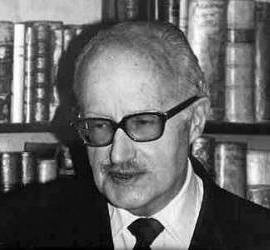 Nicolás Gómez Dávila was born in Cajicá, Colombia (near Bogotá), on May 18, 1913, into a wealthy bourgeois family. When he was six, his family moved to Europe, where they lived for the next seventeen years. During his family’s stay in Europe, young Nicolás would spend most of the year at a school run by Benedictines in Paris, but would often go for his vacations to England. However, during his time in Paris he was beset by a long-lasting illness which confined him to his bed for most of two years. It was during this illness that under the direction of private tutors he learned to read Latin and Greek fluently and to love the classics. His formal education ended at the secondary level.
Nicolás Gómez Dávila was born in Cajicá, Colombia (near Bogotá), on May 18, 1913, into a wealthy bourgeois family. When he was six, his family moved to Europe, where they lived for the next seventeen years. During his family’s stay in Europe, young Nicolás would spend most of the year at a school run by Benedictines in Paris, but would often go for his vacations to England. However, during his time in Paris he was beset by a long-lasting illness which confined him to his bed for most of two years. It was during this illness that under the direction of private tutors he learned to read Latin and Greek fluently and to love the classics. His formal education ended at the secondary level.
When Gómez Dávila turned twenty-three, he moved back to Bogotá, and almost immediately upon his return married Emilia Nieto Ramos. According to German writer Martin Mosebach, she was already married when she met Gómez Dávila, and had to obtain an annulment in order to be able to marry him. However their marriage may have started out, it lasted for over fifty years. After the wedding, the young couple moved into the house in Bogotá that was to remain their home for the course of their entire marriage. There they raised three children: two sons and a daughter.
After establishing his household, Gómez Dávila, or “don Colacho” as he became known to his friends, led a life of leisure. Because his own father was for most of his long life able to attend to the family carpet factory, Gómez Dávila only had to manage the business for a short period himself, before in turn passing it on to his son. However, even during the time when he bore primary responsibility for the business, he did not pay excessive attention to it. Mosebach reports that Gómez Dávila generally only visited the office once a week at midday for about ten minutes, in order to tell the business manager to increase profits, before going out to lunch with friends at the Bogotá Jockey Club, where he was an active member, playing polo and even serving as an officer for a while. (He had to give up polo, though, after injuring himself on his horse—he was thrown off while trying to light a cigar.)
Gómez Dávila was in fact a well-connected member of the Bogotá elite. Besides his membership in the Jockey Club, he helped Mario Laserna Pinzón found the University of the Andes in 1948. Furthermore, Gómez Dávila’s advice was sought out by Colombian politicians. In 1958, he declined the offer of a position as an adviser to president Alberto Llera after the downfall of the military government in Colombia. 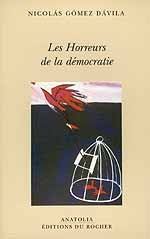 In 1974, he turned down the chance to become the Colombian ambassador at the Court of St. James. Although he was well disposed to both governments, Gómez Dávila had resolved early on in his “career” as a writer to stay out of politics. Although some of his friends were disappointed that he did not accept these offers, they later concluded (according to Mosebach) that he was right to refuse the honors—he would have been a disaster as a practical politician.
In 1974, he turned down the chance to become the Colombian ambassador at the Court of St. James. Although he was well disposed to both governments, Gómez Dávila had resolved early on in his “career” as a writer to stay out of politics. Although some of his friends were disappointed that he did not accept these offers, they later concluded (according to Mosebach) that he was right to refuse the honors—he would have been a disaster as a practical politician.
Gómez Dávila instead spent most of his life, especially after his polo injury, reading and writing in his library. He was a voracious reader, often staying up well into the night to finish a book. By the end of his life, he had accumulated a library of approximately 30,000 volumes. Indeed, his family had trouble disposing of many of the books because so many appealed primarily to specialized scholarly interests, and because so many were in languages other than Spanish. (Diego Pizano states in this article that Colombia’s Banco de la República has recently decided to acquire the library.) Gómez Dávila, besides learning French, English, Latin, and Greek during his childhood, could read German, Italian, and Portuguese, and was even reportedly learning Danish before his death in order to be able to read Søren Kierkegaard in the original. According to Francisco Pizano, Gómez Dávila regretted that he never succeeded in learning Russian—he started learning it too late in life. In addition to reading, Gómez Dávila enjoyed the company of friends whom he regularly invited to his home for lunch on Sunday afternoons. After the meal, he would retreat into his library with his friends for hours-long, wide-ranging discussions.
The result of all this reading and discussion can be found in our author’s works. Gómez Dávila, however, published these works only very reluctantly during his lifetime. Indeed, his first two works were available only to his family and friends in private editions. In 1954, at the urging of his brother Ignacio, he published Notas (Notes), a collection of aphorisms and short reflections, most no longer than a few paragraphs. In 1959, he published Textos I (Texts I), a collection of essays. The intended second volume never appeared. For nearly twenty years after these hesitant forays into publishing, Gómez Dávila re-worked what he had already produced into the aphorisms which constitute the bulk of his output as an author and for which he is best known. This period of silence ended in 1977 with the publication of two volumes of Escolios a un Texto Implícito (Scholia on the Margin of an Implicit Text). This collection of aphorism was followed in 1986 by two more volumes of Nuevos Escolios a un Texto Implícito (New Scholia on the Margin of an Implicit Text). A final volume of aphorisms was published in 1992 as Sucesivos Escolios a un Texto Implícito (Further Scholia on the Margin of an Implicit Text). 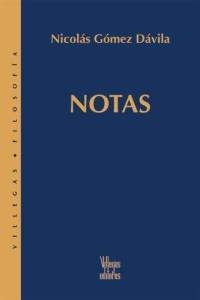 Late in life, Gómez Dávila also wrote two shorter pieces. The first, De iure (De jure) was printed in the spring 1988 issue of the Revista del Colegio Mayor de Nuestra Señora del Rosario. His final work, El Reaccionario Auténtico(The Authentic Reactionary) was published posthumously in the spring 1995 issue of the Revista de la Universidad de Antioquia; it is perhaps the most programmatic of his works. None of these works was published commercially, and none was ever printed in any great numbers during his lifetime. Notas, Textos I, and all five volumes of Escolios have recently been made available again by Villegas Editores, a Bogotá publisher. Villegas Editores has also put out a single-volume selection of aphorisms, compiled by Gómez Dávila's daughter, Rosa Emilia Gómez de Restrepo, entitled Escolios a un Texto Implícito: Selección.
Late in life, Gómez Dávila also wrote two shorter pieces. The first, De iure (De jure) was printed in the spring 1988 issue of the Revista del Colegio Mayor de Nuestra Señora del Rosario. His final work, El Reaccionario Auténtico(The Authentic Reactionary) was published posthumously in the spring 1995 issue of the Revista de la Universidad de Antioquia; it is perhaps the most programmatic of his works. None of these works was published commercially, and none was ever printed in any great numbers during his lifetime. Notas, Textos I, and all five volumes of Escolios have recently been made available again by Villegas Editores, a Bogotá publisher. Villegas Editores has also put out a single-volume selection of aphorisms, compiled by Gómez Dávila's daughter, Rosa Emilia Gómez de Restrepo, entitled Escolios a un Texto Implícito: Selección.
Gómez Dávila himself did nothing to attract attention to his work. Indeed, his deliberate choice of obscure publishing houses and tiny printing runs seems almost intended to condemn his works to oblivion. Word of Gómez Dávila, however, began to spread slowly toward the end of his own lifetime. Strangely enough, he became best known not in his native Colombia or in other Spanish-speaking countries, but in the German-speaking world. Philosopher Dietrich von Hidlebrand apparently was the first to make any reference in print in Germany to Gómez Dávila. A few years before his death, German translations of his aphorisms began to appear at the Karolinger Verlag in Vienna. Among the Germans who have professed their admiration of Gómez Dávila are several noted writers, including the late Ernst Jünger, Martin Mosebach, and Botho Strauß. Since his “discovery,” knowledge of his work has spread in other countries in Europe due to the work of a small group of devoted admirers, most especially the late Franco Volpi in Italy. Translations of his works are now also available in French, Italian, and Polish.
Gómez Dávila died in his library on the eve of his 81st birthday, on May 17, 1994.
00:05 Publié dans Philosophie | Lien permanent | Commentaires (3) | Tags : philosophie, nicolas gomez davila, amérique latine, amérique du sud, colombie, réaction, pensée réactionnaire, conservatisme |  |
|  del.icio.us |
del.icio.us |  |
|  Digg |
Digg | ![]() Facebook
Facebook


